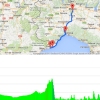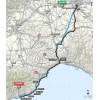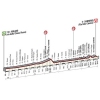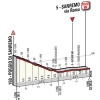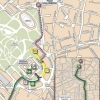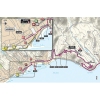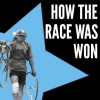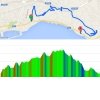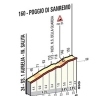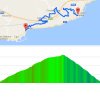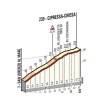The route largely copies the route of 2014, meaning the first obstacle is the Passo del Turchino after 140 kilometres in the saddle. Via the 25 kilometres slopes (at 1.4%) riders leave the Po Valley and head for the Mediterranean. Once ‘crested’ it’s a long descent and then the road flattens again for 100 kilometres.
Capos
The Capo Mele is a short steep climb, immediately followed by Capo Cervo and Capo Berta – both short but harmless. Some twenty kilometres down the road the steepest and longest ascent of the day awaits the riders – the Cipressa. The 5.5 kilometres climb at 4.1% is a perfect spot to attack when you feel powerful, especially after 3 kilometres on the slopes when the steepest section of 9% reached. With 21 kilometres left the Cipressa is crested.
Cipressa and Poggio
Whoever says Cipressa, says Poggio. The two hills are inextricably linked to the finale of Milan-San Remo. Last year the organisation tried to insert the Pompeiana between the two in order to make the race harder and to shake-up the outcome of the race. Didn’t work out, because the road at the top of the 5 kilometres climb was too damaged and the Pompeiana was skipped at the eleventh hour. Apart from the damaged road, another point worth mentioning was sprinters like Cavendish were outspoken about boycotting a Milan-San Remo containing an extra hill in the finale.
So it was back to the Cipressa-Poggio finale again and the organization didn’t even consider the Pomeaiana for edition 2015. After descending the Cipressa the traditional Poggio looms. The climb is 4 kilometres in length and with an average gradient of 3.7% it may not sound too impressive, but every rider in the pack knows the actual experience – a.k.a. your in agony screaming legs – may tell a different story after almost 300 kilometres of racing. The Poggio is the last place in the route for anti-sprinters to try their luck. The steepest section of 8% is the place to go, located just under the top.
Upon cresting a steep descent with sharp bends brings the riders to the foot of the Poggio and then its 2 kilometres to the finish line at Via Roma. In the past seven years the finish was 1 kilometre further down the road on the Lungomare Italo Calvino, a fact that should favour bold attackers, but will it be enough to disqualify the ‘natural winners’ in San Remo – the sprinters?
Via Roma
Via Roma was finish to Milan-San Remo in the years 1949-1985 and 1994-2007. Oscar Freire was the last victor at the history oozing place. Record holder on Via Roma is Eddy Merckx with seven wins.
Here you’ll find both race results and race report.
Milan – San Remo 2015: Route maps, height profiles, and more
Click on the images to zoom
